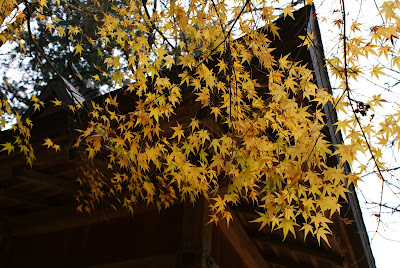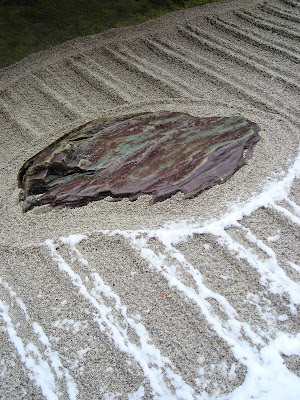18th December 2009
Rakushisha (落柿舎) is one of those attractions where people hover at the threshold, wondering if the place will be worth the entrance fee.
This is what you can see of the hermitage from the outside in autumn: persimmon trees, maple leaves and a thatched roof.

Fans of Matsuo Basho don't hesitate. Even if the current Rakushisha is a reconstruction, the original was visited by the poet three times and that connection is enough for them.
You may not be able to read the poems on the wooden plaques hung in the garden or carved on the stones. But lines in wood need no translation.

And sunlight is a universal language.

If you feel like writing a haiku, there is paper for you.

The owner of Rakushisha, poet Mukai Kyorai, probably won't read it seeing as he died in 1704. But a raincoat and hat are hung from a wall to show that the owner is in.

So you never know.
On the other hand, there is no entrance fee for Iwato Ochiba Jinja (岩戸落葉神社), a tiny mountain shrine northwest of Kyoto city. Some say that the shrine used to be called Ochikawa shrine but became known as Ochiba Jinja - the fallen leaves shrine.
In late autumn, the gingko trees soaring over the shrine shed gold leaf all over the grounds.


The leaves fill the stone basin where worshippers purify their hands and mouth.


And among the gingko, some maple too. Autumn in Kyoto wouldn't be the same without it.


1 comment:
So lovely.Rakushisha is as beautiful as I remembered from my last visit. The persimmons on the bare branches under the deep blue sky of autumn is one of my favourite memories of the place. Arashiyama in general, is really pretty in autumn.
Post a Comment